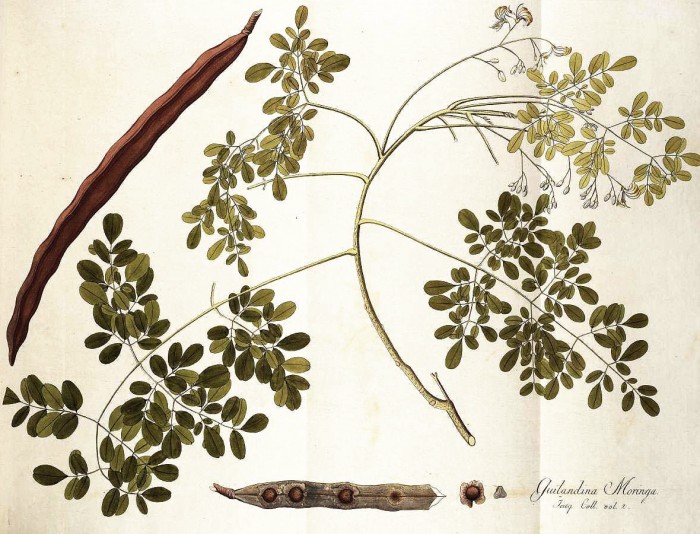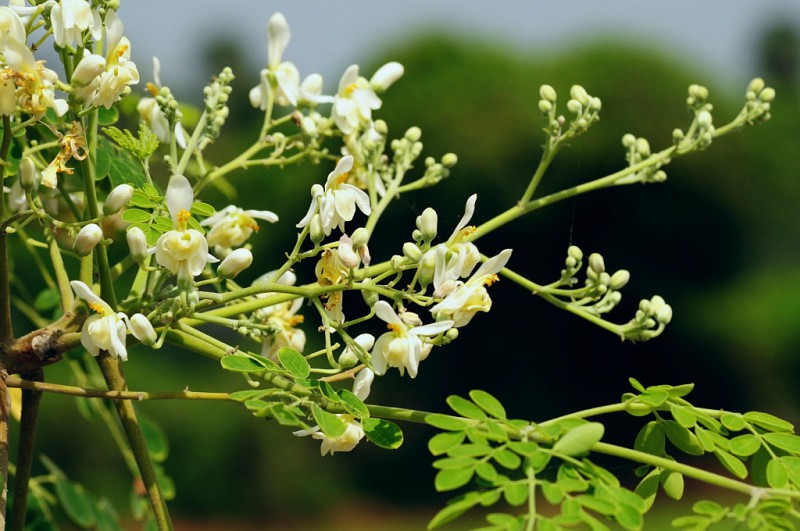Moringa oleifera Lam. - syn.Moringa pterygosperma Gaertn.; Guilandina moringa L. - Moringaceae
horseradish tree, ben (oil) tree, West Indian ben, Meerrettichbaum, Pferderettichbaum
Deciduous perennial tree, up to 10m high, native to India and Pakisten, naturalized and cultivated in tropics (Africa eg); stem and branches brittle, with corky bark; leaves alternate, pale green, tripinnately imparipinnate, 30-60 cm long, with small elliptic to obovate leaflets; flowers white or creamy-white, fragrant; fruit a 9-ribbed pendulous pod, up to 45cm long, splitting lengthwise into 3 parts when dry, containing about 20 seeds; seeds dark brown.
„The root is a substitute for horse-radish and used by Anglo-Indians in medicines as a vesicant. Flowers and immature fruits are eaten in curries and are said to be a good rubefacient. Several parts of the plant are used in native medicines and an oil known as Ben oil is extracted from the seeds and used by watch makers as a lubricant in fine machinery. The branches are often lopped for fodder.“
http://www.efloras.org/florataxon.aspx?flora_id=5&taxon_id=200009759
„4(α-L-Rhamnosyloxy)benzyl isothiocyanate was identified as an active antimicrobial agent form seeds of M.oleifera and M.stenopetala. Roots of M.oleifera only contain this compound and benzyl isothiocyanate, but not pterygospermin as previously suggested. Defatted and shell free seeds of both species contain about 8-10% of 4(α-L-rhamnosyloxy)benzyl isothiocyanate, but this amount is produced from M.oleifera only when asorbic acid is added during water extraction. The compound acts on several bacteria and fungi.“
[The Antibiotic Principle of Seeds of Moringa oleifera and Moringa stenopetala1., Eilert, U., Wolters, B., Nahrstedt, A., Planta medica, Vol.42(5), 1981, 55-61]
„Various parts of this plant such as the leaves, roots, seed, bark, fruit, flowers and immature pods act as cardiac and circulatory stimulants, possess antitumor, antipyretic, antiepileptic, antiinflammatory, antiulcer, antispasmodic, diuretic, antihypertensive, cholesterol lowering, antioxidant, antidiabetic, hepatoprotective, antibacterial and antifungal activities, and are being employed for the treatment of different ailments in the indigenous system of medicine, particularly in South Asia.“
[Moringa oleifera: a food plant with multiple medicinal uses., Anwar, F., Latif, S., Ashraf, M., Gilani, A. H., Phytotherapy research, Vol.21(1), 2007, 17-25]
http://theenergizedbody.com/wp-content/uploads/2012/06/multiplemedicalpurposes1.pdf
„Moringa oleifera Lam. contains a unique combination of isothiocyanate and glucosinolates. The effectiveness of the moringa plant in treating ovarian cancer became evident after the publication of recent studies demonstrating that benzyl isothiocyanate (BITC) and phenethyl isothiocyanate (PEITC) induce apoptosis in ovarian cancer cells in vitro…
Moringa oleifera can interfere with hormone receptor-related and neoplastic growth-related cytokine pathways via centrally acting mechanisms. It appears to have a tremendous effect on G protein-linked signal transduction system as well.“
[Possible role of Moringa oleifera Lam. root in epithelial ovarian cancer., Bose, C.K., Medscape General Medicine, Vol.9(1), 2007, 26]
http://www.ncbi.nlm.nih.gov/pmc/articles/PMC1924986/
„Moringa Oleifera leaf extract inhibited the growth of all pancreatic cell lines tested. This effect was significant in all cells following exposure to ≥0.75 mg/ml of the extract. Exposure of Panc-1 cells to Moringa leaf extract induced an elevation in the sub-G1 cell population of the cell-cycle, and reduced the expression of p65, p-IkBα and IkBα proteins in crude cell extracts. Lastly, Moringa Oleifera leaf extract synergistically enhanced the cytotoxic effect of cisplatin on Panc-1 cells.“
[Moringa Oleifera aqueous leaf extract down-regulates nuclear factor-kappaB and increases cytotoxic effect of chemotherapy in pancreatic cancer cells., Berkovich, L., Earon, G., Ron, I., Rimmon, A., Vexler, A., Lev-Ari, S., BMC complementary and alternative medicine, Vol.13(1), 2013, 212]
http://www.biomedcentral.com/1472-6882/13/212
An extract (SDE) of the sweet fragrant flowers (74 compounds identified, 99.8%) contained degradation products of different glucosinolates like isopropyl isothiocyanate (3.9%), 1-methylpropyl isothiocyanate (1.3%), 2-methylpropyl isothiocyanate (3.8%), and benzyl isothiocyanate (6.4%). Further main components were (E)-nerolidol (13.4%), α-terpineol (7.8%), 2-methylbutanol (5.6%), (Z)-3-hexenol (5.7%), (E)-2-hexenal (2.4%), (E)-2-hexenol (2.3%), linalool (4.1%), α-pinene (2.9%), and nonanal (4.1%). Several odoriferous compounds were minor components, like eg. (E)-2-nonenal, (E,Z)-2,6-nonadienal, octanal, (E)-2-octenal, decanal, (E)-2-decenal, (E,Z)-2,4-decadienal, (Z)-3-hexenyl acetate, phenylacetonitrile and phenylacetaldehyde, (E)-anethole, methyl cinnamate, cinnamyl acetate, β-damascenone, β-ionone, and (Z,E)-α-farnesene.
[Floral Scent Composition of Moringa oleifera Lam., Pino, J.A., Journal of Essential Oil Bearing Plants, 16(3), 2013, 315-317]

Moringa oleifera Lam. [as Guilandina moringa L.]
Jacquin, N.J. von, Icones plantarum rariorum, vol. 3: t. 461 (1786-1793)
http://plantgenera.org/species.php?id_species=681147

Moringa oleifera flowers, CC BY-SA 3.0, Author: Venkatx5
https://en.wikipedia.org/wiki/Moringa_oleifera#/media/File:DrumstickFlower.jpg
